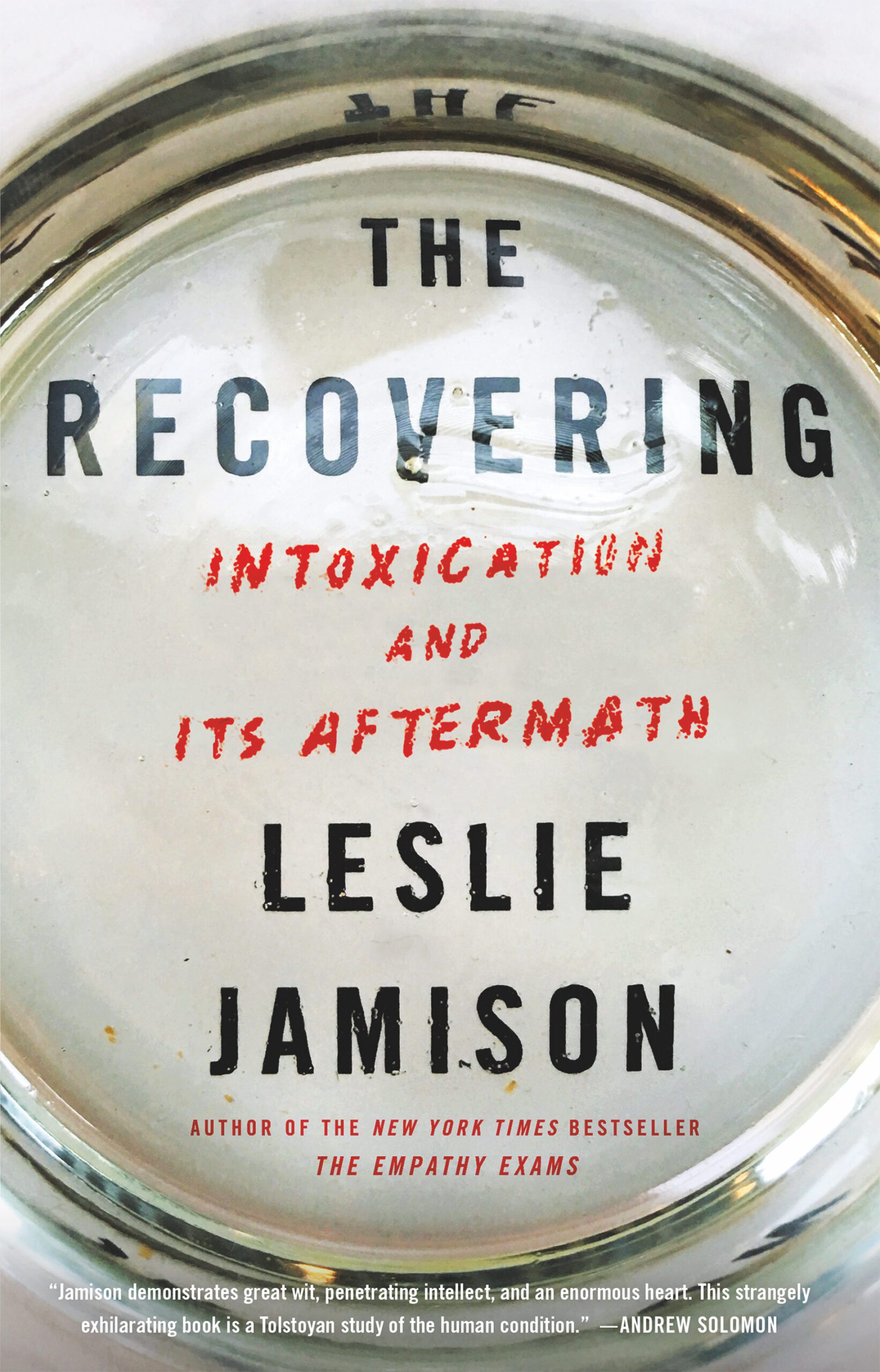
I devoured Leslie Jamison’s The Recovering: Intoxication and Its Aftermath sitting on the fringe of a hotel bar in Atlanta on a Saturday afternoon, though “guzzled” might be the better word, as I gulped word after word after word in the same way I might have gulped a magnum of cabernet before getting sober seven years ago. I was chaperoning my teenage daughter at a Furry Conference, and while she was gallivanting with other wolves, bears, and cheetahs, I sat at the bar drinking my cranberry-seltzer, underlining and starring passages from the book, and watching Propane Industry Conventioneers slam overpriced martinis and beer.
A strange juxtaposition: an otherworldy riot of plumed and furry creatures—imagination unleashed from the constraints of the pedestrian world—against business executives drowning out their lives of quiet desperation in drink. The Furries swooned over each other’s handiwork—cross-species animals (kangaroo-dragon!), color patterns, and metallic scales. Propane Conventioneers? Liberated by the third drink, they finally felt brave enough, unselfconscious enough, to ask for pictures with the Furries, to prove to the world on Instagram that TRULY! THEY COULD HAVE FUN! A perfect visual representation of Jamison’s central argument: sobriety doesn’t annihilate creativity unless such creativity is inherently dependent on the ephemeral and often tediously superficial illumination via booze or drugs. As Jamison writes in the beginning of her book, “The appeal wasn’t just about intoxication—as a portal, or a bandage—but about the alluring relationship between creativity and addiction itself: its state of thrall, its signature extremity.”
Sobriety and the recounting of stories in 12-step meetings is a leveling experience: our stories of using and abusing may differ in the facts but are exactly the same in the effects. Jamison writes:
[A]ddiction is always a story that has already been told, because it inevitably repeats itself, because it grinds down—ultimately, for everyone—to the same demolished and reductive and recycled core: Desire. Use. Repeat.
Herein lies the difficulty for Jamison in writing her story of addiction and recovering: like all memoirists, she must necessarily be in thrall to her own story as it is an act of inherent ego to presume one’s life story matters to anyone beyond immediate family and dogs and cats, and perhaps not even to them. 12-step meetings rely on such recounting through the shared, often shame-filled drunkalogs and structured tripartite “leads” (see AA’s The Big Book: What We Used To Be Like, What Happened, What We Are Like Now) as a way to reinforce community and to remind those trying to get and stay sober that they are not alone in the suffering. As she understands,
Recovery reminded me that storytelling was ultimately about community, not self-deception. Recovery didn’t say: We tell ourselves stories in order to live. It said: We tell others our stories in order to help them live, too.
I admit: when I read Jamison’s version of “What We/I Used To Be Like,” her “glorious arc of blaze and rot” which spans the first three hundred pages of an almost four-hundred-and-fifty-page book, I was enthralled by her drunkalog. That is, I read for the visceral, intoxicating charge of someone long sober in need of a proxy buzz. I read it not as a critic but as someone who could recognize her own drunk self on the page much as Jamison describes her own reaction reading Caroline Knapp’s Drinking: A Love Story—your story is my story is your story. Of the immediate, early-on effect of drinking, she writes,
Drinking felt like the opposite of restriction. It was freedom. It was giving in to wanting, rather than refusing it. It was abandon. Abandon as in recklessness, but also sudden departure: leaving behind the starving self, its cold skeletal shell.
Or further along, “Falling in love was the only sensation that had ever truly rivaled drinking—for buzz and transportation, sheer immersive force.” Or this passage which I underlined, starred, photographed, and posted on my own Instagram because it felt true in the hardest and most essential way:
The more you start to need a thing, whether it’s a man or a bottle of wine, the more you are unwittingly—reflexively, implicitly—convincing yourself you’re not enough without it.
Passages like these from Jamison’s story—and there are many—help me to live with more honest, self-critical awareness in my own recovering.
However much I deeply admire this book as someone who is also recovering (page after page of stars and underlines), I would be remiss if I didn’t speak of my hesitant reservations as someone reading with critical temperance—“hesitant” because Jamison’s memoir is an important story recounted with fierce, clear-eyed intelligence. She speaks to the often invisible experience of women alcoholics and addicts. As she notes, drunk women are depicted as
…animals or children: dumbstruck, helpless, ashamed. Their drinking was less like the necessary antidote to their own staggering wisdom—catalyst or salve for these Virgils to the fallen world—and more like self-indulgence or melodrama, hysteria, a gratuitous affliction.
And yet, Jamison begins her account with a list of first thralls: first buzz, first secret drink, first high, first drink with a boy, first blackout, first intentional blackout, first puke from drink, first lie from drink, first drinking dream, first dream about lying and drinking, and first time she ever told the story of her drinking at an AA meeting. What is absent, however, are the consequential “firsts” of drinking: first loss of job, of boyfriend, of family and friends, of kids, of marriage, of status, of income, of health, of health care, of forgiveness—the drunkalog that, for many in sobriety, is our reckoning. Some might refer to it as “the bottom.” Perhaps the absence of large-scale, cataclysmic consequences of addiction is due to the fact that she got sober at twenty-seven and is now only thirty-four. Of course, one doesn’t need to have such consequential external devastation as might occur later in life in order to choose sobriety, as the internal self can be equally wrecked by drink, but this might explain the imbalance in the division of content in the book: three-quarters devoted to “What We/I Used To Be Like” (active addiction) and one-quarter devoted to “What We/I Am Like Now” (recovering).
I don’t wish any additional suffering upon Jamison nor do I wish to define what “bottoming out” means for her, but I often skimmed through the “What It Was Like” section—especially the fetishizing of the writing program at Iowa. She writes,
I often thought about Iowa with a we: We drank here. We drank there. We drank somehow with those who would drink after us, just as we drank with those who had come before.
Instead of a star beside this passage? I wrote: “Oy vey. Exceptionalism and privilege.” (And I must also admit I would write a similar remark in the margins of my own recovery story.) Still, there are many drunks and many recovering drunks in writing programs, and to suggest that somehow the Iowa Writers’ Workshop produces a special kind of drunk, an exceptional writer drunk, feeds into the mythologizing (booze as essential to writing) Jamison is attempting to disrupt.
Of those moments that might need deeper excavation—such as drinking while pregnant, an abortion, or “the night I don’t call date rape“—Jamison offers a quick intellectualized summary, but then moves on, often to an examination of accounts by other writers of their bottoming-out degradations. As Jamison remarks late in the book, “[i]n recovery, certain kinds of difficulty are harder to confess than others,” and as I considered the narrative in entirety, I had difficulty identifying moments that felt like “harder confessing” for Jamison. While I found Jamison’s discussions of other addict artists (i.e., Berryman, Carver, Rhys, Bishop, Holiday, and Winehouse) interesting, along with her attendant close reading of their writings, and her analysis of the social, political, legal, racial, and gendered history of alcohol and drug policy important, the narrative voice in these sections felt academic rather than personal. Too much of too much, and not enough of what I was waiting for: the more enthralling account of recovering.
For me, it is not so much the content of the three-hundred-page “What We/I Used To Be Like” section that is occasionally lackluster, but its delivery. Jamison tells us that before her first “share,” she practiced with notecards, approaching honest, spontaneous revelation as the academic writer—in control of the narrative, the delivery, and the reception. Rehearsed, revised, and recovered. Of course, this points to the difficulty in writing any recovery story: how to convey the messy incoherence of addiction, of a life, in structured prose? In part, Jamison answers my question:
Maybe sometimes you just had to accept that the story of your life was a crafted thing—selected, curated, skewed in service of things you could name and probably other things you couldn’t. Maybe you could accept all that, and still believe it might do you, or someone else, some good.
Recovered. Recovering. Memoir is, in itself, an act of recovering the past, ordering events in a way that make sense to the author and offer a purposeful narrative to the reader. But recovering is a gerund: addicts (though, also, all of us in the end) are always salvaging and repurposing what came before this moment of right now. Near the end of the book, Jamison quotes a Carver poem:
It pleases me, loving rivers… Loving them all the way back / To their source. / Loving everything that increases me.
As recovering addicts, we must love ourselves back to the source, love our shameful bits and decimations and not just our reconciliations and resurrections. All that came before increases us, rather than diminishes us, which is the power of a recovering story. Ultimately, despite some writerly reservations, I found Jamison’s narrative to be a powerful testimony to why we share our stories, whether formally (as published memoir) or informally (at a 12-step meeting, over a shared meal, in a therapist’s office). Jamison writes that, “Recovery reminded me that storytelling was ultimately about community, not self-deception.” And when we show up for each other, when we listen to each other, when we share our stories with each other we acknowledge that going at this life alone? “It didn’t work, and here we are.”
***
Featured photograph of Leslie Jamison © Beowulf Sheehan.
***
Voices on Addiction is a column devoted to true personal narratives of addiction, curated by Kelly Thompson, and authored by the spectrum of individuals affected by this illness. Through these essays, interviews, and book reviews we hope—in the words of Rebecca Solnit—to break the story by breaking the status quo of addiction: the shame, stigma, and hopelessness, and the lies and myths that surround it. Sisters, brothers, mothers, fathers, adult children, extended family members, spouses, friends, employers or employees, boyfriends, girlfriends, neighbors, victims of crimes, and those who’ve committed crimes as addicts, and the personnel who often serve them, nurses, doctors, social workers, therapists, prison guards, police officers, policy makers and, of course, addicts themselves: Voices on Addiction will feature your stories. Because the story of addiction impacts us all. It’s time we break it. Submit here.





